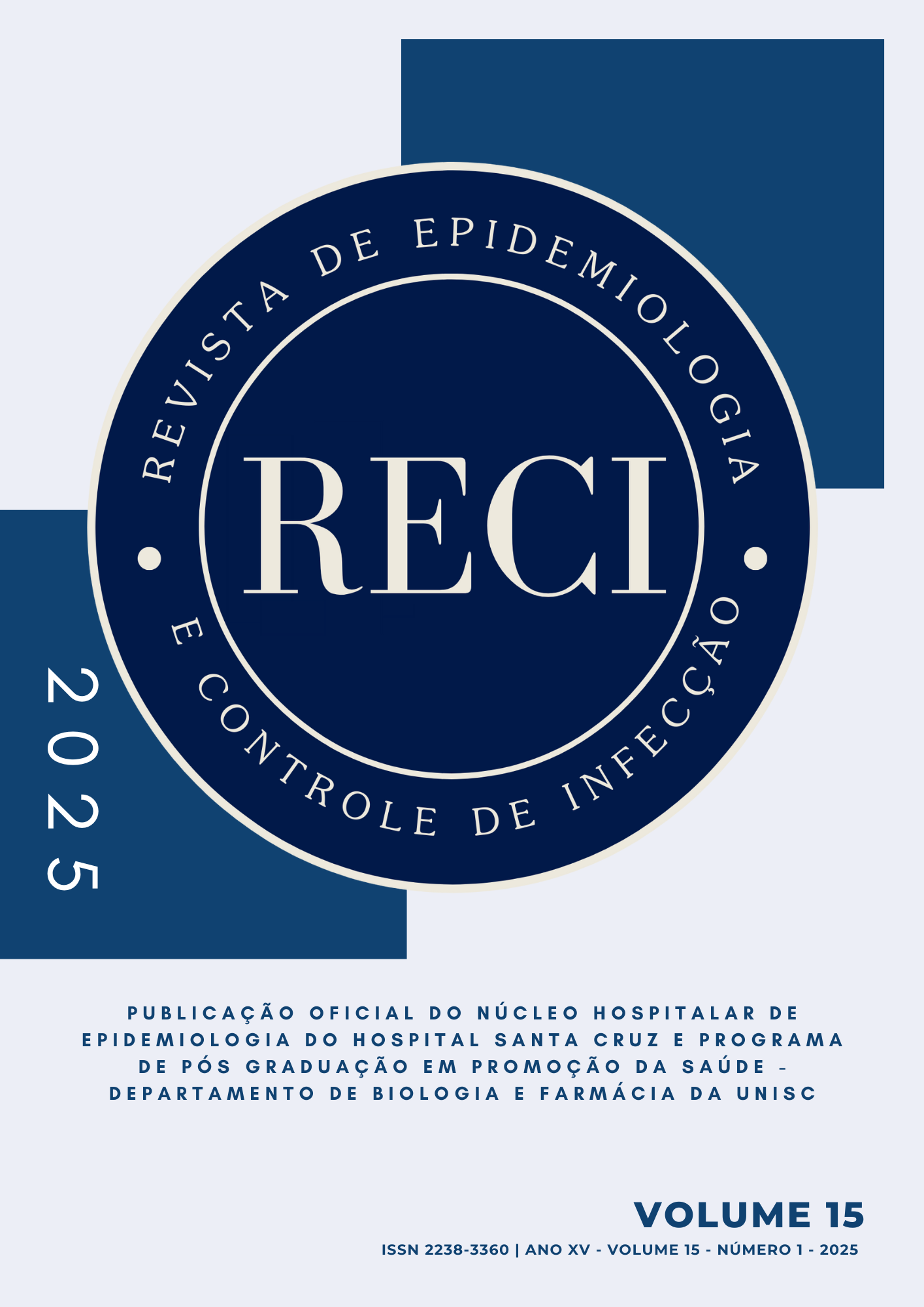Impacto del uso de antibióticos macrólidos sobre la resistencia bacteriana en las bronquiectasias no fibroquísticas: revisión sistemática
DOI:
https://doi.org/10.17058/reci.v15i1.19905Resumen
Justificación y Objetivos: las bronquiectasias son una enfermedad respiratoria crónica caracterizada por dilatación irreversible de la pared bronquial, disfunción mucociliar, tos persistente, esputo productivo e infecciones recurrentes. El uso de antibióticos es una parte esencial del tratamiento de las bronquiectasias por fibrosis no quística, siendo habitual el uso de macrólidos por sus propiedades antiinflamatorias y su eficacia en las enfermedades neutrofílicas. Sin embargo, el uso frecuente de macrólidos es preocupante debido a su potencial para inducir resistencia a los antimicrobianos. En este sentido, este artículo evaluó el impacto de la terapia con antibióticos macrólidos en las bronquiectasias por fibrosis no quística sobre la aparición de resistencia bacteriana. Métodos: se trata de una revisión sistemática descriptiva, realizada en las bases de datos PubMed, LILACS y SciELO, que incluye todos los artículos publicados hasta agosto de 2020 que estaban disponibles en portugués, inglés y/o español, encontrados por las palabras clave “resistencia a los antimicrobianos” y “bronquiectasias”. Por otro lado, se excluyeron revisiones, artículos de opinión y editoriales, y aquellos trabajos que no investigaran la resistencia bacteriana, especialmente a los antibióticos macrólidos. Resultados: la revisión encontró cinco estudios, todos realizados entre 2008 y 2016 en Australia, Nueva Zelanda y Países Bajos, que evaluaron los efectos de los macrólidos en niños y adultos con bronquiectasias. Cuatro fueron ensayos clínicos controlados y uno fue un estudio de cohorte prospectivo. Aunque los estudios han demostrado que los macrólidos fueron eficaces para reducir las exacerbaciones y mejorar la función pulmonar, también han informado el desarrollo de resistencia a los macrólidos en algunos casos. Este artículo enfatiza la necesidad de un uso cauteloso de macrólidos en el tratamiento de bronquiectasias no relacionadas con la fibrosis quística debido al potencial de resistencia a los antimicrobianos.
Descargas
Referencias
Laska IF, Crichton ML, Shoemark A, et al. The efficacy and safety of inhaled antibiotics for the treatment of bronchiectasis in adults: a systematic review and meta-analysis. Lancet Respir Med. 2019;7(10). https://doi.org/10.1016/S2213-2600(19)30185-7
Martins KB, Olmedo DWV, Paz MM, et al. Staphylococcus aureus and its Effects on the Prognosis of Bronchiectasis. Microb Drug Resist. 2021;27(6):823–34. https://doi.org/10.1089/mdr.2020.0352
Pereira MC, Athanazio RA, Roth Dalcin P de T, et al. Consenso brasileiro sobre bronquiectasias não fibrocísticas. J Bras Pneumol. 2019;45(4):e20190122. http://doi.rg/10.1590/1806-3713/e20190122
Yates B, Ahmad T, Doherty M, Watson G. Bronchiectasis. Am J Respir Crit Care Med. 2015;192(7):859-860. https://doi.org/10.1164/rccm.201507-1449LE
Kelly C, Chalmers JD, Crossingham I, Relph N, Felix LM, Evans DJ, Milan SJ, Spencer S, Cochrane Airways Group. Macrolide antibiotics for bronchiectasis. Cochrane Database Syst Rev. 2018; (3). https://doi.org/10.1002/14651858.CD012406.pub2
Gaynor M, Mankin AS. Macrolide Antibiotics: Binding Site, Mechanism of Action, Resistance. Curr. Top. Med. Chem. 2003; 3 (9), 949-961. https://doi.org/10.2174/1568026033452159
Wang D, Fu W, Dai J. Meta-analysis of macrolide maintenance therapy for prevention of disease exacerbations in patients with noncystic fibrosis bronchiectasis. Med (United States). 2019;98(17): e15285. http://doi.org/10.1097/MD.0000000000015285
Ghosh S, Bornman C, Zafer MM. Antimicrobial Resistance Threats in the emerging COVID-19 pandemic: Where do we stand? J. Infec. Public Health. 2021; 14(5):555-560. https://doi.org/10.1016/j.jiph.2021.02.011
Ferri M, Ranucci E, Romagnoli P, et al. Antimicrobial resistance: A global emerging threat to public health systems. Crit Rev Food Sci Nutr. 2017;57(13):2857-2876. http://doi.org/10.1080/10408398.2015.1077192
Inchingolo R, Pierandrei C, Montemurro G, et al.. Antimicrobial resistance in common respiratory pathogens of chronic bronchiectasis patients: A literature review. Antibiotics. 2021;10(3):326. http://doi.org/10.3390/antibiotics10030326
Serisier DJ, Martin ML, McGuckin MA, et al. Effect of long-term, low-dose erythromycin on pulmonary exacerbations among patients with non-cystic fibrosis bronchiectasis: The BLESS randomized controlled trial. JAMA. 2013;309(12):1260-1267. http://doi.org/10.1001/jama.2013.2290
Altenburg J, De Graaff CS, Stienstra Y, et al. Effect of azithromycin maintenance treatment on infectious exacerbations among patients with non-cystic fibrosis bronchiectasis: The BAT randomized controlled trial. JAMA. 2013;309(12):1251-1259. http://doi.org/10.1001/jama.2013.1937
Valery PC, Morris PS, Byrnes CA, et al. Long-term azithromycin for Indigenous children with non-cystic-fibrosis bronchiectasis or chronic suppurative lung disease (Bronchiectasis Intervention Study): A multicentre, double-blind, randomised controlled trial. Lancet Respir Med. 2013;1(8):610-620. http://doi.org/10.1016/S2213-2600(13)70185-1
Goyal V, Grimwood K, Byrnes CA, et al. Amoxicillin–clavulanate versus azithromycin for respiratory exacerbations in children with bronchiectasis (BEST-2): a multicentre, double-blind, non-inferiority, randomised controlled trial. Lancet. 2018;392(10154):1197-1206. http://doi.org/10.1016/S0140-6736(18)31723-9
Hare KM, Singleton RJ, Grimwood K, et al. Longitudinal Nasopharyngeal Carriage and Antibiotic Resistance of Respiratory Bacteria in Indigenous Australian and Alaska Native Children with Bronchiectasis. PLoS One. 2013;8(8). https://doi.org/10.1371/journal.pone.0070478
Zavala-Flores and Salcedo-Matienzo. Medicación prehospitalaria en pacientes hospitalizados por COVID-19 en un hospital público de Lima-Perú. Acta Med Peru 2020; 37(3):393–395. http://dx.doi.org/10.35663/amp.2020.373.1277
Sultana J, Cutroneo PM, Crisafulli S, et al. Azithromycin in COVID-19 Patients: Pharmacological Mechanism, Clinical Evidence and Prescribing Guidelines. Drug Saf [Internet]. 2020;43(8):691–8. https://doi.org/10.1007/s40264-020-00976-7
Freires MS, Rodrigues Junior OM. Resistência bacteriana pelo uso indiscriminado da azitromicina frente a Covid-19: uma revisão integrativa. Res Soc Dev. 2022;11(1). https://doi.org/10.33448/rsd-v11i1.25035
Athanazio R, Rached S. O uso de macrolídeos para bronquiectasias, Pneumologia Paulista 2016; 29 (1). http://itarget.com.br/newclients/revista-sppt/wp-content/uploads/2016/02/PP01032016.pdf
WORLD HEALTH ORGANIZATION (WHO). WHO report on surveillance of antiotic consumption. https://www.who.int/publications/i/item/who-report-on-surveillance-of-antibiotic-consumption
Murray CJ, Ikuta KS, Sharara F, et al. Global burden of bacterial antimicrobial resistance in 2019: a systematic analysis. Lancet 2022; 399 (10325):629-655. https://doi.org/10.1016/S0140-6736(21)02724-0
Serisier DJ. Risks of population antimicrobial resistance associated with chronic macrolide use for inflammatory airway diseases. Vol. 1, The Lancet Respir. Med. 2013. https://doi.org/10.1016/S2213-2600(13)70038-9
Descargas
Publicado
Número
Sección
Licencia
Derechos de autor 2025 Nadine Kinetz Funck, Marcelle Oliveira Garcia, Daniel Wenceslau Votto Olmedo, Daniela Fernandes Ramos

Esta obra está bajo una licencia internacional Creative Commons Atribución 4.0.
The author must state that the paper is original (has not been published previously), not infringing any copyright or other ownership right involving third parties. Once the paper is submitted, the Journal reserves the right to make normative changes, such as spelling and grammar, in order to maintain the language standard, but respecting the author’s style. The published papers become ownership of RECI, considering that all the opinions expressed by the authors are their responsibility. Because we are an open access journal, we allow free use of articles in educational and scientific applications provided the source is cited under the Creative Commons CC-BY license.


